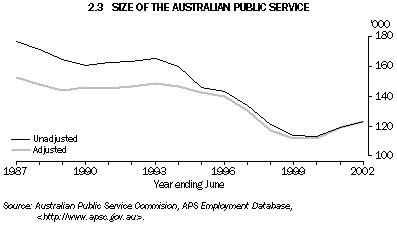The APS provides policy advice to the Australian Government and facilitates the delivery of programs to the community. The APS is part of the broader public sector, which includes parliamentary departments and staff, Australian-owned companies, statutory authorities, a separate public service for each of the states and territories, and local government employees. As at August 2002, some 1.5 million Australians, 16.9% of the employed work force, worked in the public sector; there were nearly 123,500 employees in the APS at 30 June 2002 (graph 2.3). Over the past 15 years, a number of functions, such as that provided by the former Commonwealth Employment Service, have been moved out of the APS. The 'unadjusted' line in graph 2.3 shows the actual size of the APS over the period 1987-2002. The 'adjusted' line shows the number of APS employees adjusted for changes in APS coverage that have occurred during that period.
There are currently 18 departments in the APS. Each department is managed by a chief executive officer, or secretary, who is responsible to the relevant minister for the efficient, effective and ethical use of resources. The minister, in turn, takes political responsibility for the actions of the department. Each department administers particular legislation that is specified in Administrative Arrangements. The management of financial and human resources is governed by Commonwealth legislation such as the Financial Management and Accountability Act 1997 and the Public Service Act 1999. Public servants are required to uphold the values and standards of behaviour specified in the Public Service Act 1999. These include responsiveness to the Government, high ethical standards, accountability, impartiality, merit in employment, integrity, courtesy, lawfulness, confidentiality and the proper use of resources. As well as answering to the relevant minister, the APS is accountable to the Australian community through a variety of mechanisms including parliamentary committees, administrative law, the Ombudsman and the Auditor-General.
Over the last two decades, the APS has undergone substantial change, both in its internal management processes and in its methods of service delivery. Examples of management changes include the introduction of accrual budgeting in the 1999-2000 Budget, an emphasis on reaching performance targets, the costing of government 'outputs', the imposition of capital use charges, the devolution of responsibility to departments and more flexible employment practices. Examples of changes to service delivery include the trend towards providing information and other services on the Internet, increased contracting of service delivery to the private sector and the establishment of customer service charters.
Public resources are harnessed by the public sector to give practical effect to government policies. Traditionally, this process has been known as public administration. Increasingly, it is known as public management, reflecting the growing expectation that public sector managers will take responsibility for achieving results, as well as the increasing emphasis on efficiency.

 Print Page
Print Page